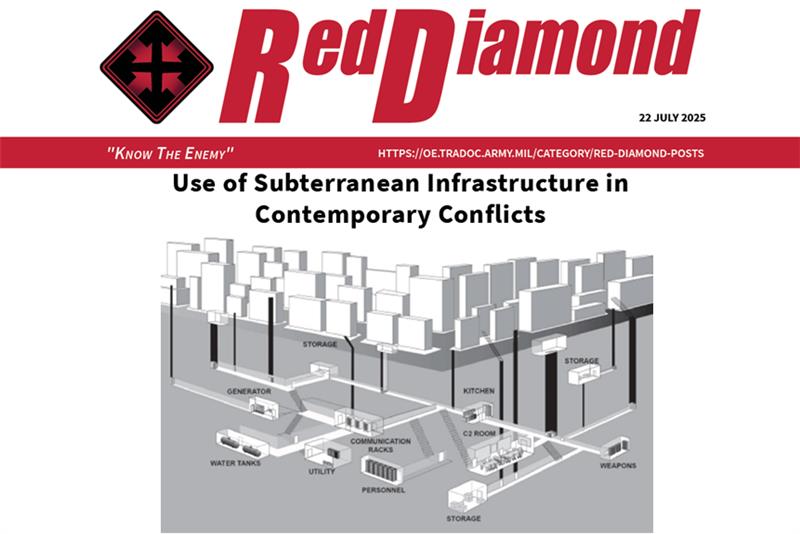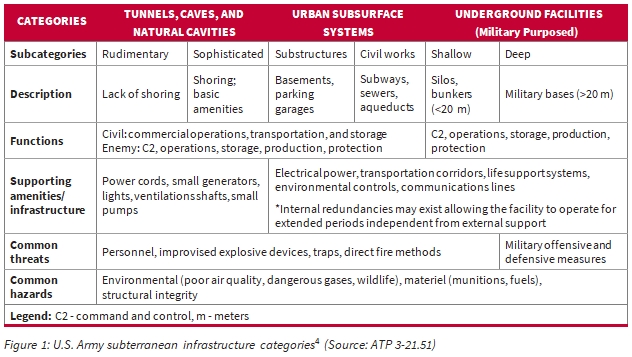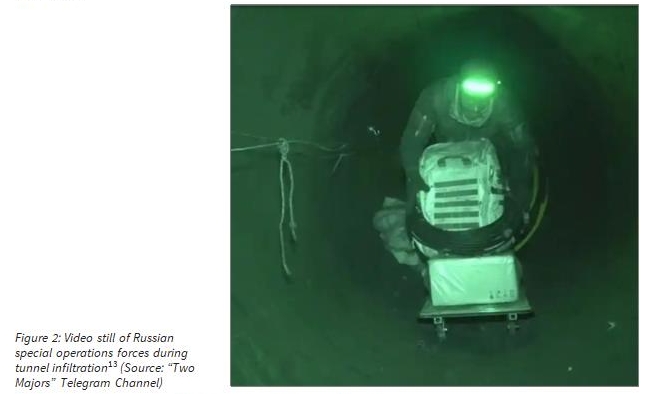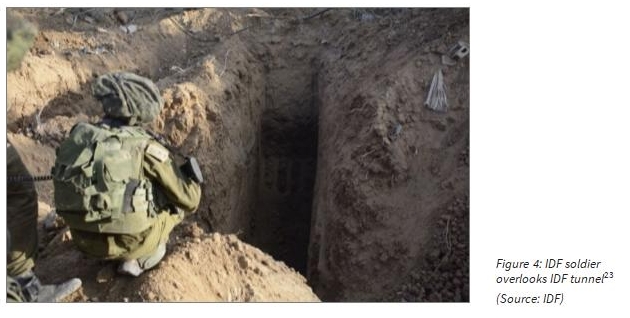
Use of Subterranean Infrastructure in Contemporary Conflicts
By Dorsel D. Boyer II
Ongoing conflicts show how subterranean infrastructure is capable of delaying enemy forces and allowing tenacious defense of urban areas, while during offensive operations it provides avenues for attacking forces to mask their movements and gain tactical advantage.1 Army Techniques Publication (ATP) 3-21.51, Subterranean Operations, defines subterranean infrastructure as any space or structure located below ground. The ATP identifies three broad categories of subterranean infrastructure: 1) tunnels, caves, and natural cavities; 2) urban subsurface systems; and 3) underground facilities (see Figure 1).2 ATP 3-21.51 notes that each category of subterranean infrastructure presents unique challenges to military operations, further explaining that systems intended for one purpose, such as command and control, may be repurposed for another purpose, such as storage or for use as a fighting position.3 The ongoing Russia-Ukraine and Israel-Hamas conflicts provide instructive examples of the unique challenges posed to forces operating in the subterranean environment, including the use of each category of subterranean infrastructure.

Subterranean Infrastructure Can Facilitate Maneuver
Russia used industrial subterranean infrastructure to successfully conceal the infiltration of special operations forces (SOF) into the Ukrainian perimeter during the clearance of the village of Sudza in March 2025, increasing pressure on Ukrainian defenders before Ukraine was forced to withdraw from the Kursk salient. Russian Special Purpose Forces launched a high-risk infiltration using approximately 15 kilometers of the Urengoy–Pomary–Uzhhorod natural gas pipeline to conceal the movement of around 100 troops from observation by Ukrainian drones, highlighting how increased battlefield transparency has driven tactical experimentation in the use of subterranean areas to gain offensive tactical surprise.5 The Russians, planning counterattacks to clear the Ukrainian lodgment in the Kursk region, sought to use the inactive pipeline to gain access to the rear of Ukrainian positions in Sudzha via the Sudzha gas pumping station in order to cut Ukrainian supply lines.6
Ultimately, however, poor planning and preparation stymied the Russian infiltration via the gas pipeline. Both Russian and Ukrainian commentators claim that the Russian infiltration team was not prepared for the long-distance movement through the confined space of the tunnel system.7, 8 Poor intelligence preparation and improper equipment challenged the Russian deployment. Leaked videos indicate that multiple members of the assault force suffered from hypoxia and methane poisoning.9, 10
Russian forces have also used other subterranean infrastructure to breach Ukrainian defensive positions. In March 2024, Russian troops overwhelmed Ukrainian defensive positions near Avdiivka by combining assault groups to fix beleaguered defenders with small infiltration teams utilizing sewer and water culvert systems to flank Ukrainian positions.11 This combination of tactics resulted in a withdrawal under pressure from a position that had anchored the Ukrainian defensive line in central Donetsk Oblast since 2014.12

Urban Subterranean Systems Can Aid Defenders
Ukraine’s integration of existing urban subterranean infrastructure during the defense of Bakhmut in 2022-23 allowed Ukrainian forces to improve their survivability against massed fires and slow Russian forces’ maneuver. Ukrainian forces have operated in urban substructures, civil infrastructure, and industrial facilities; the use of mines, basements, and sewers was a significant feature of the brutal fighting in Bakhmut and Soledar during the winter of 2022-23.14 Ukrainian defenders utilized the cities’ and surrounding region’s urban subterranean systems to limit the effectiveness of Russian artillery and slow the Russian advance by complicating Russian forces’ ability to identify Ukraine’s defensive positions.15 Ukrainian defenders used basements as command posts and protective shelters for both military personnel and civilians. These makeshift subterranean facilities were augmented by a system of tunnels, trenches, and culverts, allowing Ukrainian forces to maneuver and consolidate defensive positions.16 By using Bakhmut’s available subterranean systems, Ukrainian forces were able to inflict an estimated 17,000 Russian casualties there from 6-31 January 2023 alone.17

Underground Military Facilities Can Slow Even Highly Capable Forces
In Gaza, Hamas relies on underground facilities deliberately built to increase the group’s security, mobility, and survivability during conflicts with Israel. Hamas has built a vast system encompassing approximately 450 miles of tunnels.19 Hamas’s purpose-built tunnel system has been expanding for decades and has created a subsurface “second Gaza” due to its size and complexity.20 This military subterranean infrastructure is made to protect command and control, provide logistics, and enable covert movement.
This subterranean infrastructure continues to challenge Israel Defense Forces (IDF) intelligence collection and logistical support, allowing Hamas to slow the pace of IDF clearing operations in response to the 7 October 2023 attacks against Israeli civilians. Hamas’ subterranean infrastructure has been used to provide command and control, enable operations, provide protection for Hamas militants, and frustrate IDF attempts to recover hostages.21 IDF reporting indicates that, as of April 2025, only 25 percent of the Hamas subterranean system has been cleared or destroyed.22 Tenacious Hamas defense centering on these tunnels demonstrate how these subterranean conditions will challenge the balance of maneuver, fires, and protection for future belligerents.

Implications for the U.S. Army
As the U.S. Army considers the future use of subterranean infrastructure in large-scale combat operations, intelligence professionals, staffs, and maneuver forces must factor the unique environmental considerations required to succeed in these environments.
Significant Feature in Urban Terrain. Combat in Ukraine has primarily featured urban subsurface systems, while prepared tunnel systems in Gaza present a hybrid of all categories. U.S. Army personnel will likely encounter subterranean infrastructure of all three identified types during LSCO, suggesting exercise designers as well as commanders and unit staffs will need to consider their offensive and defensive implications.
Planning Challenges. As in the case of Russia’s use of the Urengoy-Pomary-Uzhhorod Pipeline, military planners must make careful considerations to the hazards inherent in subterranean operations. Poorly mapped underground infrastructure presents opportunities for ambush, unfamiliar surroundings can lead to disorientation, and unforeseen environmental factors like a lack of oxygen or the presence of toxic gases can threaten force and mission.
Intelligence and Staff Support. Supporting and executing the operations process—plan, prepare, execute, and assess—becomes more challenging when planning for and executing subterranean operations. The hidden nature of an underground facility’s interior spaces makes it difficult for a staff to assist the commander in driving the operations process, specifically with respect to understanding and visualizing the operation. A comprehensive information collection plan is necessary to reduce uncertainty surrounding the exterior of the underground facility or subterranean network, allowing the commander and staff to focus on the less defined aspects of subterranean operations.
Notes
Zabrodskyi, Mykhaylor, Jack Watling, Oleksandr V. Danylyuk, and Nick Reynolds. Preliminary Lessons in Conventional Warfighting from Russia’s Invasion of Ukraine, February-July 2022. London: Royal United Services Institute for Defence and Security Studies, 2022
U.S. Army TRADOC, TRADOC PAM 252-92, The Operational Environment 2024-2034, 2024, hxxps:// rdl.train.army.mil/catalog- ws/view/100.ATSC/26EDC9BD-A6C6-4BD8-B663-88DB4528F896-1734185694520/TP525-92_Final.pdf
Ibid.
Ibid.
Newdick, Thomas. 2025. “Russian Raiders Crawled for Miles through Gas Pipeline to Attack Ukrainians in Kursk.” The War Zone. March 10, 2025. hxxps://www.twz.com/land/russian-raiders-crawled-for-miles-through-gas-pipeline-to-attack-ukrainians- in-kursk
Bellamy, Daniel. 2025. Msn.com. 2025. https://www.msn.com/en-in/news/world/russian-forces-use-gas-pipeline-to-attack- ukrainian-troops-in-kursk/ar-AA1Az0rm?ocid=BingNewsVerp.
“Два майора.” 2025. Telegram. 2025. hxxps://t.me/dva_majors/66171%20.
Stezhensky, Alex. 2025. “Trapped and Terminated: Russian Troops’ Gas Pipeline Infiltration Ends in Disaster.” New Voice. NV. 2025. hxxps://english.nv.ua/russian-war/russian-troops-failed-pipeline-infiltration-ends-in-heavy-losses-near-sudzha-50496621. html.
“Romanov Лайт.” 2025. Telegram. May 6, 2025. hxxps://t.me/s/romanov_92.
10 Lima, Juliana Cruz, and Will Stewart. 2025. “Putin Troops Suffer ‘Never before Seen’ LUNG POISONING after Being Ordered to Crawl down 10m Gas Pipe to At…” The US Sun. March 26, 2025. hxxps://www.the-sun.com/news/13872311/putin-troops- lung-poison-ukraine-pipe-attack/.
Два майора.” 2025. Telegram. 2025. hxxps://t.me/dva_majors/66171%20.
FP Explainers. 2023. “What’s Ukraine Hiding in the ‘Underground Cities’ of Bakhmut and Soledar?” Firstpost. January 10, 2023. hxxps://www.firstpost.com/explainers/russia-ukraine-war-underground-cities-bakhmut-soledar-salt-mines-wagner- group-11959712.html.
Distribution A: Approved for public release
Categories:
Tags:
Use of Subterranean Infrastructure in Contemporary Conflicts
By Dorsel D. Boyer II
File Size:
567KB
File Type:
Page Count:
6

